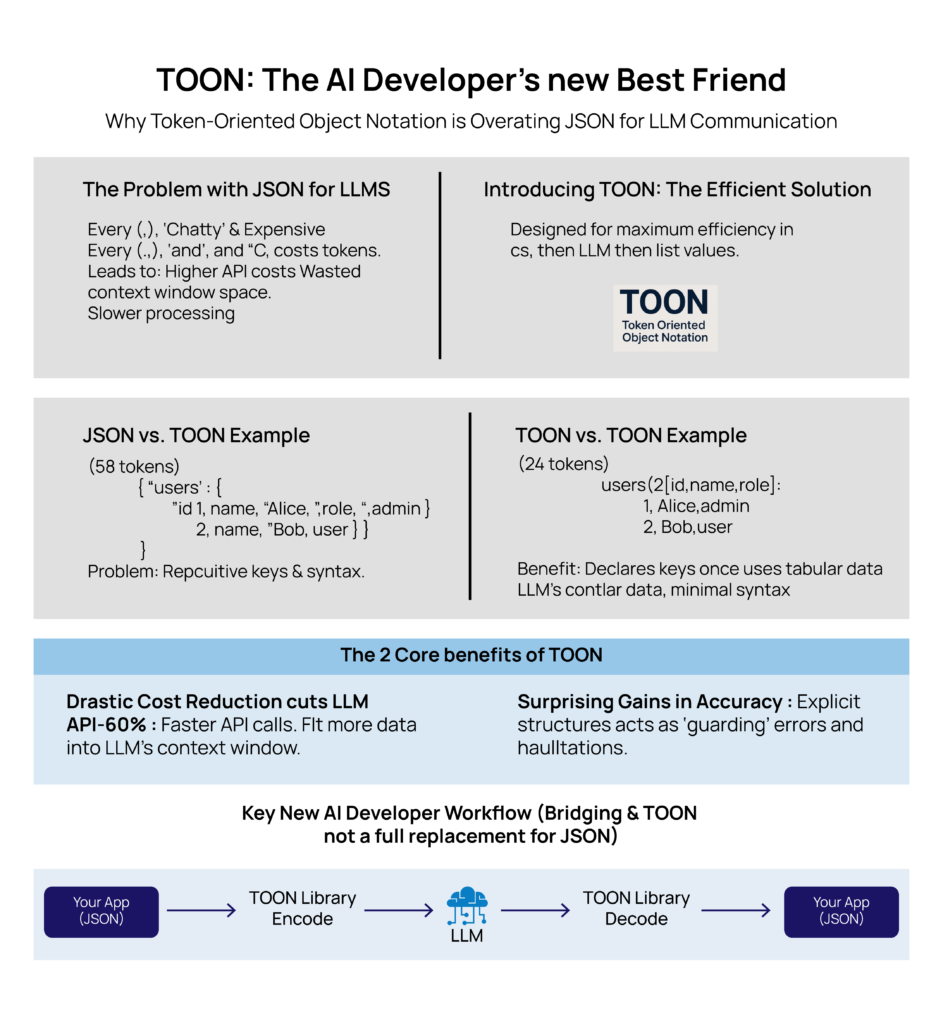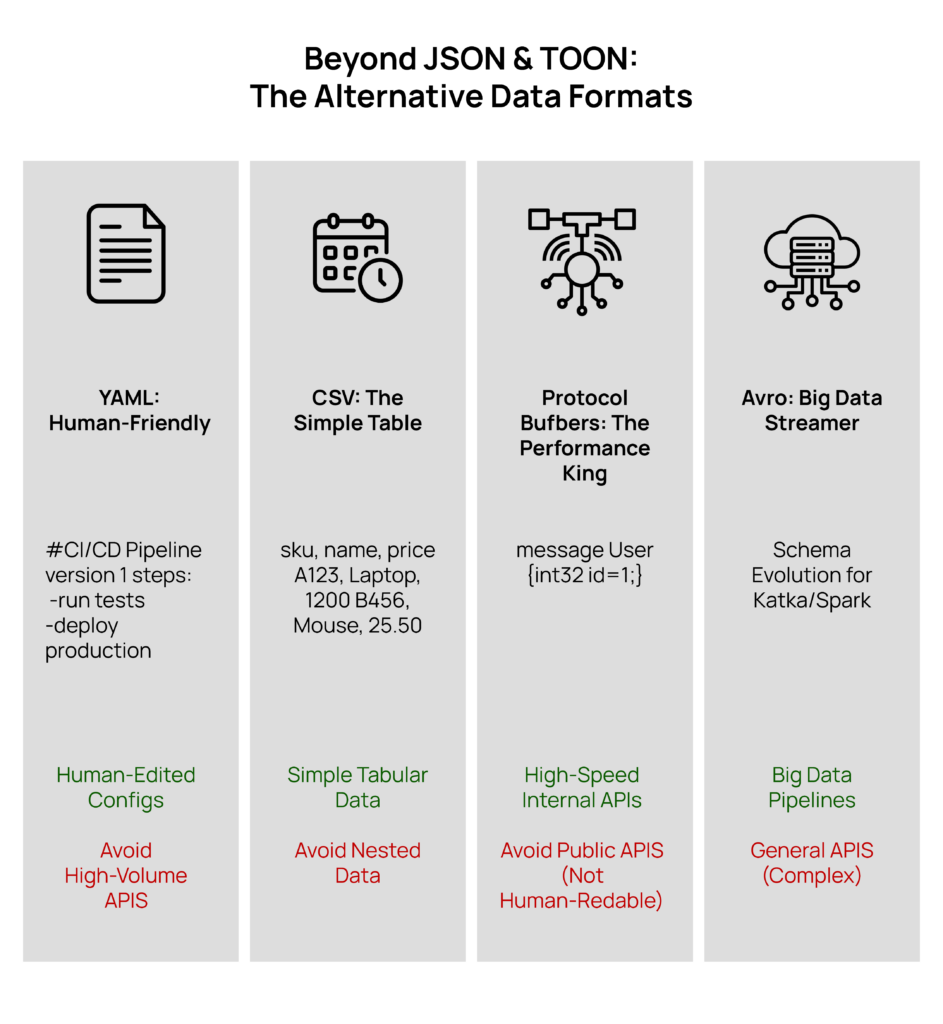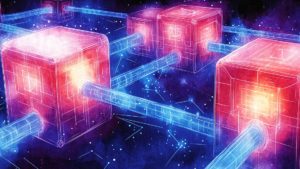


Srinath Srinivasan
5 Minutes read
The AI Developer's Guide to Data Formats: TOON vs. JSON and Beyond
For decades, JSON (JavaScript Object Notation) has been the dominant format for data interchange. It power’s web APIs, configuration files, and application data across nearly every modern system. But in the new era of Large Language Models (LLMs), this long trusted workhorse has a hidden, expensive flaw: it’s too chatty.
Every brace, bracket, comma, and quotation mark in a JSON consumes tokens. When you make thousands of API calls to models like GPT or Gemini, those extra characters translate to real money and slower performance. This is where TOON (Token-Oriented Object Notation) enters the picture. It is not designed to replace JSON for general development, but to act as a highly efficient translation layer for structured data that needs to be passed to an LLM.

What is TOON?
TOON is a data serialization format that strips away the syntactic noise typically found in JSON. It blends the readability of YAML with the tabular efficiency of CSV. The philosophy behind TOON is simple: declare the structure once, then provide the values. This approach is especially efficient for data that appears frequently in AI workflows, such as lists of uniform objects or database-style rows.
The difference is best shown with an example.
The JSON vs. TOON Showdown
Imagine a simple list of users from your database.
JSON (58 tokens):
{
“users”: [
{ “id”: 1, “name”: “Alice”, “role”: “admin” },
{ “id”: 2, “name”: “Bob”, “role”: “user” }
]
}
JSON repeats keys like “id”, “name”, and “role” in every object, and includes multiple layers of structural characters ({}).
Now, in TOON (24 tokens):
users[2]{id,name,role}:
1,Alice,admin
2,Bob,user
The difference is dramatic. TOON achieves this 58% token reduction through three simple ideas:
- Declaring Keys Once: The header users[2]{id,name,role}: establishes the entire structure. It says, “Here comes a list called users containing 2 items. Each item will have the fields id, name, and role.”
- Tabular Data: The following lines are just the data, presented like rows in a CSV file.
- Minimal Syntax: All redundant brackets, braces, and most quotes are eliminated.
The 3 Core Benefits of Using TOON
Adopting TOON isn’t just a minor optimization; it has three significant, tangible benefits for AI applications.
- Drastic Cost Reduction
The primary motivation is saving money. LLM APIs charge per token for both input and output. By cutting token usage on structured data by 30 to 60 percent, TOON directly reduces your API cost. For applications sending large batches of data for analysis, summarization, or RAG (Retrieval-Augmented Generation), the savings can be significant. - Increased Performance and Context
- Faster API Calls: Reduced data size means quicker uploads and faster LLM processing.
- More Context Available: Every LLM has a limited context window (e.g., 128k tokens). JSON’s verbosity wastes this precious space. TOON allows you to send significantly more rows, more document chunks, and more examples in a single request.
- Surprising Gains in Accuracy
This benefit is critical, and often overlooked, benefit. You might think a more obscure format would confuse the LLM, but benchmarks show the opposite. TOON can actually improve the LLM’s parsing reliability. The explicit structure of TOON acts as “guardrails” for the model. For example, users[2] tells the model exactly how many items to expect, reducing hallucinations, missing fields, or incomplete lists. Structured formats with clear explanations often produce cleaner, more predictable responses.
The New AI Developer Workflow: A Translation Layer
TOON does not replace JSON in your application stack. Instead, it becomes a crucial translation layer applied only when interacting with an LLM.
The new developer workflow will look like this:
- Internal Data: Your application and database will continue using JSON for flexibility, database storage and general interoperability.
- LLM Input: Right before sending data to an LLM, a TOON encoder converts your JSON into a compact TOON string.
- LLM Output: You will instruct the LLM to provide its structured response in the compact TOON format, which you then easily parse back into JSON for your application to use.
Your Full Decision Guide: When to Use What
TOON is a specialized tool, not a universal replacement. Here’s a breakdown of when to use each format.
When to Use JSON (The Universal Standard)
Use JSON for 90% of your work. It remains the default and universal standard.
Use JSON When:
- Building RESTful APIs for your web or mobile app.
- Storing data in a NoSQL database like MongoDB or DynamoDB.
- Exchanging data between any two modern services.
- Your data is complex, deeply nested, or has an irregular structure.
Do NOT Use JSON When:
- Your primary concern is raw performance (use binary formats).
- Your configuration file is complex and hand-edited by humans (use YAML).
- You are sending large arrays of data to an LLM (use TOON for this specific step).
When to Use TOON (The AI Specialist)
Use TOON for one job: Communicating with LLMs.
Use TOON When:
- You are sending data to an LLM API (like GPT, Gemini, or Claude).
- You are receiving structured data from an LLM.
- Your data is tabular or in arrays of objects.
- You want to reduce API costs and improve performance.
Do NOT Use TOON For:
- General web APIs (no browser or server supports it natively).
- Database storage.
- Application configuration files.
Deeply nested or irregular data (it will be less efficient than JSON).

When to Use Neither (The Alternatives) Sometimes, neither JSON nor TOON is the right tool. If you find yourself frustrated by their limitations, you probably need one of these.

| Format | When to Use It (The “Sweet Spot”) | When to Avoid It |
| YAML | Human-Edited Config Files. Use it for files that people must read and write by hand. Its support for comments and cleaner syntax is ideal. Examples: Kubernetes, Docker Compose. | Data Interchange / APIs. It is slower to parse than JSON and its indentation rules can cause errors. |
| CSV | Simple Tabular Data. Use it for exporting/importing data to spreadsheet programs (Excel, Google Sheets) or for very simple, flat data logs. | Hierarchical or Nested Data. It’s impossible to represent complex objects or lists within lists. |
Protocol Buffers (Protobuf) | High-Performance Internal APIs. This is a binary format that is incredibly fast and compact. It’s the industry standard for microservices communication. | Public APIs or Web Browsers. It is not human-readable and requires a schema file to be understood. |
| Avro | Big Data Streaming Pipelines. This binary format is designed for schema evolution. It’s perfect for systems like Kafka, Hadoop, and Spark. | General API or data storage. It’s overkill and complex for most applications. |
Summary: Your Decision Guide
Use this simple chart to make a quick decision.
| Scenario | Format |
| Sending data to an LLM | TOON |
| Writing a human-edited config file | YAML |
| Building a high-speed internal microservice | Protobuf |
| Building a Big Data pipeline (Kafka/Spark) | Avro |
| Exporting data to Excel | CSV |
| Doing literally anything else (Web APIs, storage, etc.) | JSON |
Conclusion
As LLMs become core components of modern software systems, developers must rethink how data is prepared and transmitted. JSON will remain the universal standard, but its verbosity creates unnecessary cost and inefficiency when communicating with LLMs. TOON fills this gap by providing a lightweight, structured, and token-efficient alternative that improves cost, speed, and reliability. By using TOON as a translation layer rather than a replacement, AI developers gain the best of both worlds. This shift represents an important evolution in how we optimize AI-driven applications and make better use of every token.
Related Insights


The Architecture of Agentic RAG: Reasoning-Driven AI Systems Explained

The AI Developer’s Guide to Data Formats: TOON vs. JSON and Beyond


Closed-Loop Energy & Carbon Optimization for Manufacturing Lines

